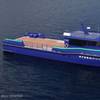AFMA Moves to Strengthen Seabird Safety
Being followed by an albatross is considered to bring good luck to mariners but the birds themselves aren’t always so lucky when trying to pick up a free feed from fishing boats.
To better protect seabirds from fishing gear, AFMA has been working with the fishing industry to develop new devices for fishers to use.
Following successful sea trials of two new devices led by the South East Trawl Fishing Industry Association (SETFIA) and the Great Australian Bight Fishing Industry Association (GABIA), the Australian Fisheries Management Authority (AFMA) has approved two new seabird mitigation devices, the “bird baffler” and “sprayer”, for use by fishers.
The sea trials showed dramatic reduction in seabird interactions when using either of these two devices.
Given this fantastic result, from 1 May 2017, all vessels in the South East Trawl and Great Australian Bight Trawl fisheries must use one of the following mitigation devices:
Sprayers
Bird bafflers
Pinkies with zero discharge of fish waste.
The new requirements will be mandated from the start of the 2017/18 fishing season to give operators time to make modifications to their boats, but AFMA encourages operators to fit the new devices or move to zero discharge of fish waste when using “pinkies”, as soon as possible.
AFMA’s CEO Dr James Findlay said that it was great to see industry working to further reduce the impact of fishing operations on the environment.
“AFMA congratulates SETFIA and GABIA in leading the development of best practice technology to protect seabirds around fishing boats,” Dr Findlay said.
“AFMA will continue to work with the fishing industry and scientists to ensure that the risk of protected species interactions with fishing operations is minimised.”
Dr Geoff Tuck, Research Team Leader at the CSIRO and member of the project Steering Committee said that the fishing industry can now apply new mechanisms to further reduce seabird interactions that are flexible enough to be tailored to each vessel.
industry-science-management project is an excellent example of how these groups can work together for positive environmental outcomes,” Dr Tuck said.













